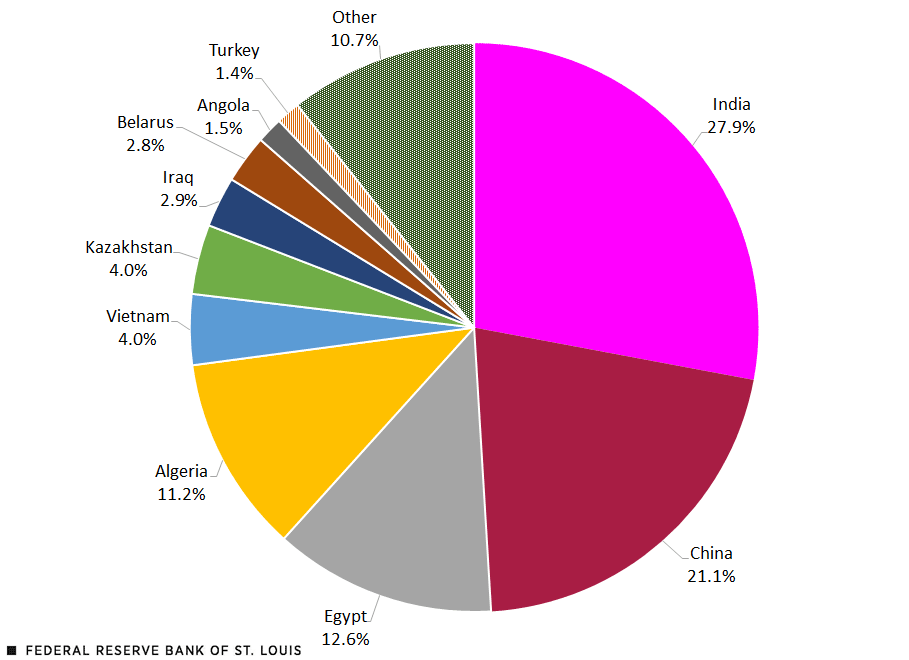The Arms Trade and Its Bearing on the Russia-Ukraine War
The U.S. economy is linked to the global economy through the supply chain and international trade, among other factors. Disruptions related to Russia’s invasion of Ukraine in February 2022 and associated trade sanctions have contributed to shortages and boosted inflationary pressures in the U.S. and abroad. Similarly, conflict in the Middle East in the 1970s contributed to global inflationary pressures. Possible future conflicts will likely also have adverse economic impacts.
With that in mind, this blog post discusses some relevant facts about the arms trade, which ties nations to each other through security interests. Depending on their nature, such linkages may exacerbate or help to resolve international conflicts. In the following analysis, we describe the pattern of international trade in arms and comment on how arms trade linkages may have a bearing on the Russia-Ukraine war.
Global Trade in Weapons
China, France, Germany, Russia and the U.S. were the world’s top five weapons-exporting nations from 2017 to 2021. The figure below traces their shares of global weapons exports since 1950. From the beginning of the period until the breakup of the Soviet Union in 1991, the U.S. and Soviet Union were the predominant exporters.
The pattern is somewhat different in the 1990s, with Russia’s export share falling short of France’s or Germany’s share in some years. It is interesting to note that three of the largest weapons exporters (the U.S., Germany and France) are NATO members, and collectively they exceed Russia’s or China’s share of arms exports in every year since 1991.
Top 5 Arms Exporters (2017-21) and Their Historical Share of Global Exports

SOURCES: Stockholm International Peace Research Institute and authors’ calculations.
NOTE: The top five arms exporters were determined based on export shares from 2017 to 2021.
The next figure presents the corresponding data for the world’s top weapons importers. It shows the world’s top five weapons-importing nations from 2017 to 2021 and their shares going back to 1950. The only nation that is both a top importer and exporter of weapons is China, which suggests the country has a strong defense production base but still imports certain arms as appropriate for its defense needs. In this group of top weapons importers, India and Saudi Arabia have alternated as the largest importers over the last decade. India is a large country that has long-standing border disputes with Pakistan and China, while Saudi Arabia is in the Persian Gulf region. The Persian Gulf region is critical for the global oil market, as well as for security in the proximate area, which includes Iran, Israel and Egypt, among other nations.
Top 5 Arms Importers (2017-21) and Their Historical Share of Global Imports

SOURCES: Stockholm International Peace Research Institute and authors’ calculations.
NOTE: The top five arms importers were determined based on import shares from 2017 to 2021.
Arms Trade Patterns for the U.S. and Russia
Two interesting questions arise in light of the data regarding top arms exporters: Who are the largest importers of U.S. arms? And do these same nations also import arms from Russia?
The first pie chart below shows that from 2017 to 2021, Japan was the largest importer of U.S. arms, followed by Saudi Arabia and South Korea. Saudi Arabia is a major player in the oil market and its security is quite central to U.S. interests. Similarly, U.S. security interests in the Pacific region are tied to Japan’s and South Korea’s defense capabilities.
Top Importers of U.S. Arms, 2017–2021

SOURCES: Stockholm International Peace Research Institute and authors’ calculations.
On the other hand, the second pie chart below shows that India and China were the largest importers of Russian arms from 2017 to 2021. India had long-standing defense ties with the Soviet Union, and its current arms trade with Russia is partly a legacy of those ties. China has the second-largest defense budget in the world after the U.S. and relies on the well-established Russian defense production network for some of its advanced weapons. This arms trade interdependence among India, China and Russia complicates U.S. foreign policy initiatives to bring the two Asian giants to exert political pressure on Russia to end the Russia-Ukraine war.
Top Importers of Russian Arms, 2017–2021

SOURCES: Stockholm International Peace Research Institute and authors’ calculations.
Arms Trade and International Linkages
Trade in arms links nations in the spheres of international politics and security. The fact that the U.S. is the world’s largest arms exporter, and that the U.S. and its allies are putting their weight behind Ukraine’s defense, works in Ukraine’s favor. Then again, Russia is itself a dominant arms producer, and it is linked to India and China through arms trade. Such international linkages, among other factors, complicate the path to a quick political resolution of the Russia-Ukraine war. However, the humanitarian and economic tolls of this conflict are mounting and likely can only be contained through a mutually acceptable political agreement.
Citation
Subhayu Bandyopadhyay and Praew Grittayaphong, ldquoThe Arms Trade and Its Bearing on the Russia-Ukraine War,rdquo St. Louis Fed On the Economy, Nov. 21, 2022.
This blog offers commentary, analysis and data from our economists and experts. Views expressed are not necessarily those of the St. Louis Fed or Federal Reserve System.
Email Us
All other blog-related questions



